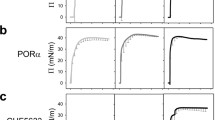Summary
The physical principles for developing a synthetic lung surfactant to treat the respiratory distress syndrome are discussed. Requirements for the lipid composition and preparation of the synthetic surfactant are detailed, leading to the conclusion that a suspension of large unilamellar vesicles consisting of dipalmitoylphosphatidylcholine and a small amount of unsaturated lipid is a promising choice.
Riassunto
Si discutono i princípi fisici per sviluppare un agente tensioattivo sintetico per trattare la sindrome di rischio respiratorio. Sono descritte in dettaglio la composizione e la preparazione dei lipidi del tensioattivo sintetico, e ciò porta alla conclusione che una sospensione di grandi vescicole unilamellari che consistono di dipalmitolfosfatidilcolina e di una piccola quantità di lipide non saturo è una scelta proficua.
Резюме
Обсуждаются физические принципы разработки синтетического поверхностно-активного вещества легкого для лечения синдрома респираторного недомогания. Анализируются требования для липидного состава и приготовления синтетического поверхностно-активного вещества. Отмечается, что суспензия больших униламинарных пузырьков, состоящих, из dipalmitoylphosphatidylcholine и малого количества ненасыщенных липидов, липидов, является наиболее перспективной.
Similar content being viewed by others
References
J. A. Clements:Am. Rev. Respir. Dis.,115, 67 (1977).
R. J. King andJ. A. Clements:Am. J. Physiol.,223, 715 (1972).
M. Ikegami, T. Hesterberg, M. Nozaki andF. H. Adams:Pediatr. Res.,11, 178 (1977).
G. Enhörning andB. Robertson:Pediatrics,50, 58 (1972).
T. Fujiwara andF. H. Adams:Pediatrics,66, 795 (1980).
M. Oblanden, D. Popp, C. Schöll, H. Schwarz, andF. Jähnig: to be published inBiochim. Biophys. Acta.
H. Träuble, H. Eibl andH. Sawada:Naturwissenschaften,61, 344 (1974).
S. Schürch, J. Goerke andJ. A. Clements:Proc. Natl. Acad. Sci. USA,73, 4698 (1976).
H. Schindler:FEBS Lett.,122, 77 (1980).
H. Schindler:Biochim. Biophys. Acta 555, 316 (1979).
S. T. Sun, E. P. Day andJ. T. Ho:Proc. Natl. Acad. Sci. USA,75, 4325 (1978).
a)F. Jähnig:Biophys. J. 36, 329 (1981);b)36, 347 (1981).
S. Mitaku, A. Ikegami, andA. Sakanishi:Biophys. Chem.,8, 295 (1978).
M. Ikegami, J. Silverman andF. H. Adams:Pediatr. Res.,13, 777 (1979).
A. D. Bangham, C. J. Morley andM. C. Phillips:Biochim. Biophys. Acta,573, 552 (1979).
Author information
Authors and Affiliations
Rights and permissions
About this article
Cite this article
Jähnig, F., Obladen, M. The physical principles for developing a synthetic lung surfactant. Il Nuovo Cimento D 3, 211–218 (1984). https://doi.org/10.1007/BF02452213
Received:
Issue Date:
DOI: https://doi.org/10.1007/BF02452213




